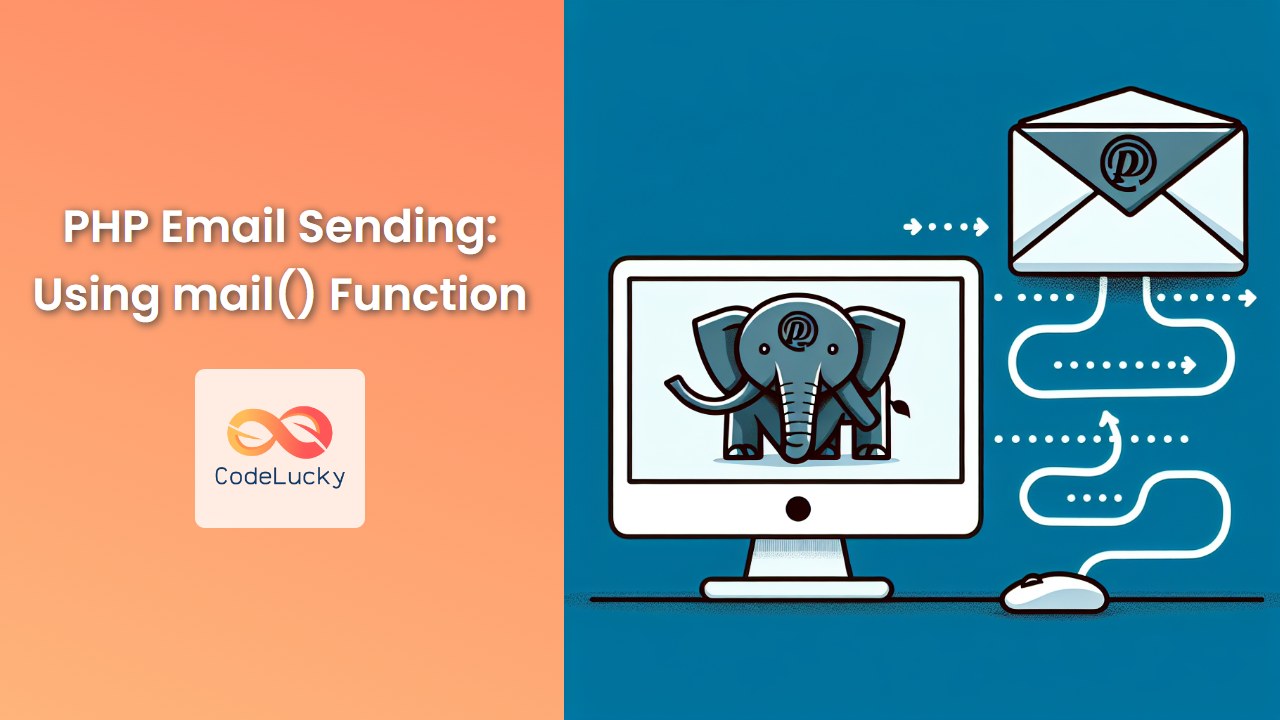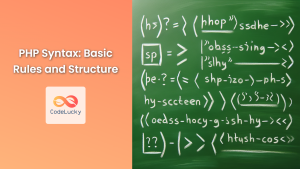📧 Sending emails programmatically is a crucial skill for any PHP developer. Whether you’re building a contact form, a newsletter system, or an automated notification service, understanding how to send emails using PHP is essential. In this comprehensive guide, we’ll dive deep into the mail() function, exploring its capabilities, limitations, and best practices.
Understanding the mail() Function
The mail() function is PHP’s built-in method for sending emails. It’s simple to use but powerful enough for many common email tasks. Let’s break down its syntax:
bool mail(string $to, string $subject, string $message, string|array $additional_headers = [], string $additional_params = "")
$to: The recipient’s email address$subject: The subject of the email$message: The body of the email$additional_headers: Optional. Additional headers like “From”, “Cc”, “Bcc”$additional_params: Optional. Additional parameters to be passed to the program configured to send emails
🔍 The function returns true if the mail was successfully accepted for delivery, false otherwise. However, a true return value only indicates that the email was accepted for delivery, not that it was actually delivered.
Sending a Simple Email
Let’s start with a basic example of sending an email:
<?php
$to = "[email protected]";
$subject = "Test Email from PHP";
$message = "Hello! This is a test email sent from PHP using the mail() function.";
if(mail($to, $subject, $message)) {
echo "Email sent successfully!";
} else {
echo "Email sending failed.";
}
?>
In this example, we’re sending a plain text email to [email protected]. The subject is “Test Email from PHP”, and the message body is a simple greeting.
🚀 When you run this script, it will attempt to send the email and display a success or failure message based on the return value of the mail() function.
Adding Headers
Headers allow you to customize various aspects of your email. Let’s enhance our previous example by adding a “From” header:
<?php
$to = "[email protected]";
$subject = "Test Email from PHP";
$message = "Hello! This is a test email sent from PHP using the mail() function.";
$headers = "From: [email protected]\r\n";
$headers .= "Reply-To: [email protected]\r\n";
$headers .= "X-Mailer: PHP/" . phpversion();
if(mail($to, $subject, $message, $headers)) {
echo "Email sent successfully!";
} else {
echo "Email sending failed.";
}
?>
In this enhanced version:
- We’ve added a “From” header to specify the sender’s email address.
- We’ve included a “Reply-To” header, which is useful when you want replies to go to a different address than the sender’s.
- We’ve added an “X-Mailer” header, which identifies the mailer software (in this case, PHP and its version).
💡 Headers are separated by \r\n (carriage return followed by line feed), which is the standard line ending for email headers.
Sending HTML Emails
While plain text emails are sufficient for simple messages, HTML emails allow for rich formatting and design. Here’s how to send an HTML email:
<?php
$to = "[email protected]";
$subject = "HTML Email Test";
$message = "
<html>
<head>
<title>HTML Email</title>
</head>
<body>
<h1>Welcome to CodeLucky!</h1>
<p>This is an <b>HTML email</b> sent from PHP.</p>
<p>Visit our website: <a href='https://codelucky.com'>CodeLucky.com</a></p>
</body>
</html>
";
$headers = "MIME-Version: 1.0\r\n";
$headers .= "Content-type: text/html; charset=UTF-8\r\n";
$headers .= "From: [email protected]\r\n";
if(mail($to, $subject, $message, $headers)) {
echo "HTML email sent successfully!";
} else {
echo "HTML email sending failed.";
}
?>
In this HTML email example:
- We’ve created an HTML message with formatting and a hyperlink.
- We’ve set the
Content-typeheader totext/htmlto indicate that the email contains HTML content. - We’ve included the
MIME-Versionheader, which is standard for HTML emails.
🎨 HTML emails allow you to create visually appealing messages with images, links, and styled text, enhancing the user experience.
Sending Attachments
Sending attachments with the mail() function requires a bit more work. We need to use MIME encoding to include the attachment. Here’s an example of how to send an email with an attachment:
<?php
$to = "[email protected]";
$subject = "Email with Attachment";
$message = "Please find the attached file.";
$filename = "document.pdf";
$file = "/path/to/document.pdf";
$content = file_get_contents($file);
$content = chunk_split(base64_encode($content));
$separator = md5(time());
$headers = "From: [email protected]\r\n";
$headers .= "MIME-Version: 1.0\r\n";
$headers .= "Content-Type: multipart/mixed; boundary=\"" . $separator . "\"\r\n";
$body = "--" . $separator . "\r\n";
$body .= "Content-Type: text/plain; charset=\"iso-8859-1\"\r\n";
$body .= "Content-Transfer-Encoding: 7bit\r\n\r\n";
$body .= $message . "\r\n";
$body .= "--" . $separator . "\r\n";
$body .= "Content-Type: application/octet-stream; name=\"" . $filename . "\"\r\n";
$body .= "Content-Transfer-Encoding: base64\r\n";
$body .= "Content-Disposition: attachment\r\n\r\n";
$body .= $content . "\r\n";
$body .= "--" . $separator . "--";
if (mail($to, $subject, $body, $headers)) {
echo "Email with attachment sent successfully.";
} else {
echo "Email sending failed.";
}
?>
This script does the following:
- Reads the file content and encodes it in base64.
- Creates a unique boundary string to separate different parts of the email.
- Constructs the email body with both the message and the attachment, using the MIME multipart format.
📎 With this method, you can attach various types of files to your emails, such as PDFs, images, or documents.
Best Practices and Considerations
When using the mail() function, keep these best practices in mind:
-
Validate Email Addresses: Always validate email addresses before sending. PHP provides the
filter_var()function withFILTER_VALIDATE_EMAILfor this purpose.$email = "[email protected]"; if (filter_var($email, FILTER_VALIDATE_EMAIL)) { // Email is valid, proceed with sending } else { echo "Invalid email address"; } -
Handle Special Characters: When sending emails with non-ASCII characters, ensure proper encoding. For subjects, you can use the
mb_encode_mimeheader()function:$subject = mb_encode_mimeheader("Résumé Received", "UTF-8"); -
Spam Prevention: To reduce the likelihood of your emails being marked as spam:
- Use a valid “From” address
- Include an unsubscribe link in marketing emails
- Avoid using all caps or excessive exclamation marks
-
Security: Be cautious when using user-supplied data in your emails to prevent header injection attacks. Always sanitize user inputs.
-
Testing: Always test your email functionality thoroughly, including checking how emails appear in different email clients.
-
Rate Limiting: Be aware of any sending limits imposed by your hosting provider to avoid being blocked for sending too many emails.
Limitations of mail()
While the mail() function is convenient, it has some limitations:
- Limited error reporting
- No built-in support for SMTP authentication
- Can be slower for sending bulk emails
- May not work on all hosting environments
For more advanced email functionality, consider using libraries like PHPMailer or SwiftMailer, which offer features like SMTP support, better error handling, and more robust attachment handling.
Conclusion
The mail() function in PHP provides a straightforward way to send emails directly from your scripts. While it has its limitations, it’s suitable for many basic email tasks and is widely supported across different hosting environments.
🚀 By mastering the mail() function, you’ve added a valuable tool to your PHP toolkit. Whether you’re sending simple notifications or complex HTML emails with attachments, you now have the knowledge to implement email functionality in your PHP applications.
Remember to always follow best practices, especially regarding security and spam prevention, to ensure your emails are both safe and deliverable. Happy coding, and may your emails always reach their destination! 📨💻



















